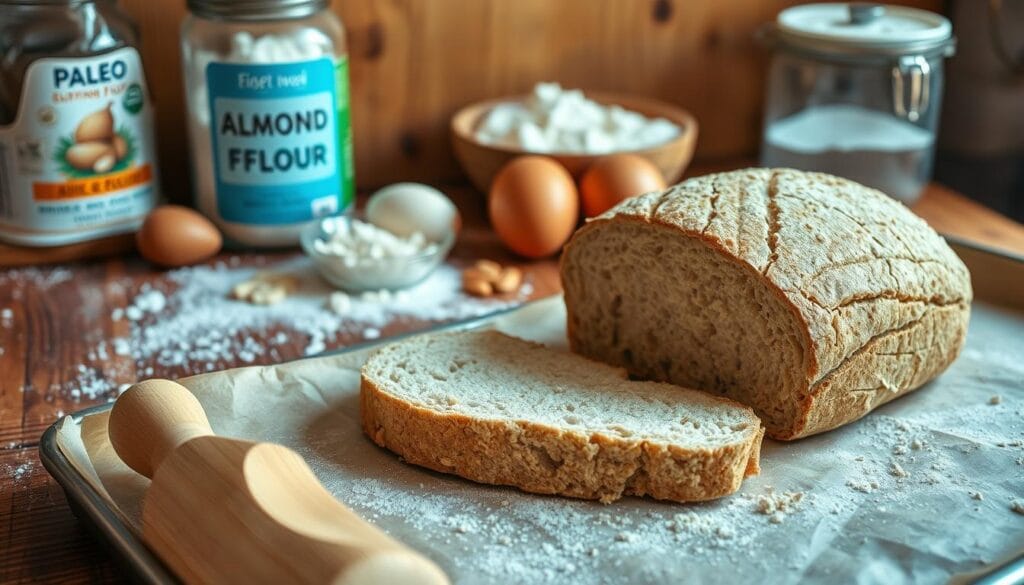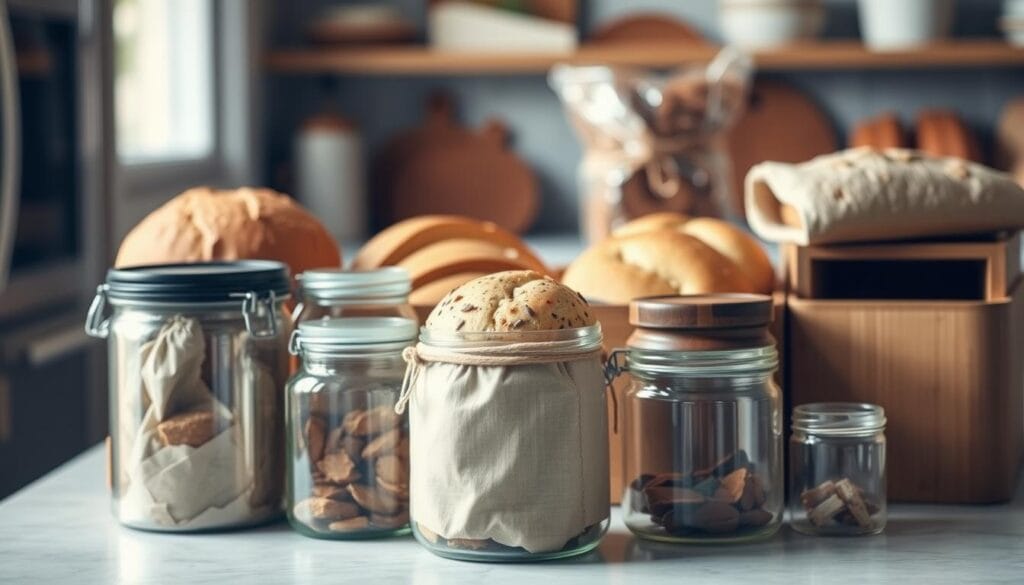Have you ever felt stuck by dietary rules that limit your bread choices? I remember when I found paleo bread. It was a big change for me, offering a healthier, gluten-free option that’s tasty and soft.
Paleo bread is a new way to bake. It’s different from regular bread, which is full of grains and processed stuff. This recipe lets you make a bread that’s not only good for you but also delicious.
If you’re on a paleo diet or just want to eat less grain, this bread is great. It has only 4 net carbs per serving. So, you can enjoy it without feeling bad, knowing it’s good for your body.
Table of Contents
Understanding Paleo Bread Basics and Benefits
Paleo bread is a new way to eat that goes back to our ancient roots. It’s made without grains and is full of nutrients. This makes it a great choice for those looking to eat healthier.
What Makes Bread Paleo-Friendly
Paleo bread is very different from regular bread. It doesn’t have grains and uses ingredients that are good for you. It’s all about being low in carbs and high in nutrients.
- Absence of refined grains
- Using alternative flour sources
- Minimizing processed ingredients
- Maximizing nutritional value
Health Benefits of Grain-Free Bread
Choosing grain-free bread can really help your health. Studies show it can:
- Help control blood sugar
- Improve digestion
- Lower inflammation
- Help with weight management
Common Paleo Flour Alternatives
Instead of ancient grains, we use new flour types that are tasty and healthy. Here are some favorites:
| Flour Type | Nutritional Highlights | Best Used For |
|---|---|---|
| Almond Flour | High protein, low-carb | Soft, moist breads |
| Coconut Flour | High fiber, low glycemic | Dense, hearty breads |
| Cassava Flour | Grain-free, neutral taste | Lighter texture breads |
Learning about these flours lets you make tasty, healthy bread. It’s perfect for reaching your health goals and enjoying delicious food.
Essential Ingredients for Perfect Paleo Bread
Making great paleo bread begins with the right ingredients. Almond flour and coconut flour are the base, offering a healthy choice over wheat flour. They give paleo bread its special texture and taste.
Choosing the right ingredients is key to making perfect paleo bread. Here’s what you’ll need:
- Almond flour (2 cups) – provides a rich, nutty base
- Coconut flour (2 tablespoons) – adds moisture and structure
- Arrowroot flour (optional) – helps improve bread texture
- Eggs (3 large) – act as a primary binding agent
- Coconut oil (1/3 cup) – adds healthy fats
The secret to great paleo bread is finding the right mix of flours. Almond flour makes it light and fluffy. Coconut flour adds density by soaking up moisture. Arrowroot flour can be used a little to make the bread even better.
| Ingredient | Quantity | Purpose |
|---|---|---|
| Almond Flour | 2 cups | Primary flour base |
| Coconut Flour | 2 tablespoons | Moisture absorption |
| Eggs | 3 large | Binding and structure |
| Coconut Oil | 1/3 cup | Healthy fat source |
“The right ingredients transform paleo bread from a simple alternative to a culinary delight.” – Paleo Baking Experts
Don’t worry if the ingredients seem different. With a bit of practice, you’ll get the hang of making tasty and healthy bread. Each ingredient is important for a successful loaf.
Bread and Paleo: Finding the Perfect Balance
Exploring paleo bread opens up a world of tasty options. These alternatives challenge old bread-making ways. They offer nutrition and flavor through new techniques.
Starting your paleo bread journey is exciting. You’ll find alternatives that change how we think about bread. Cassava flour is a standout, offering a texture like wheat but staying true to paleo.
Traditional vs. Paleo Bread Differences
- Texture: Denser and more nutrient-rich
- Ingredients: Grain-free alternatives like almond and cassava flour
- Nutritional profile: Higher protein and lower carbohydrate content
- Baking methods: Specialized techniques for grain-free success
Adapting to Grain-Free Baking
Learning to make paleo bread takes time and practice. You’ll need to adjust your baking methods. Cassava flour is a great choice for a bread-like experience.
Texture and Taste Expectations
Paleo bread is different from traditional bread. It has a denser, moist texture and rich, nutty flavors. While it’s not the same as wheat bread, it has its own unique taste that many enjoy.
| Characteristic | Traditional Bread | Paleo Bread |
|---|---|---|
| Main Flour | Wheat Flour | Cassava, Almond |
| Calories per Slice | 120-150 | 180-220 |
| Protein Content | 3-4g | 6-9g |
Your paleo bread journey offers nutritious, tasty options. These choices respect your diet and taste buds.
Step-by-Step Basic Paleo Bread Recipe
Making delicious paleo bread at home is simple. This gluten-free recipe uses easy, healthy ingredients. They add flavor and health benefits to your baking.
Let’s look at the key ingredients for your paleo bread:
- 5 large eggs
- ⅓ cup light olive oil
- 1 ½ cups blanched almond flour
- 3 tablespoons tapioca flour
- ¼ cup ground flaxseed meal
- 1 tablespoon baking powder
- ½ teaspoon sea salt
Here’s how to prepare your paleo bread:
- Preheat your oven to 350°F (177°C)
- Grease a 9×5 inch loaf pan
- Whisk eggs and olive oil in a large mixing bowl
- Combine dry ingredients in a separate bowl
- Gradually mix dry ingredients into wet ingredients
- Pour batter into prepared loaf pan
- Bake for 35-40 minutes until golden brown
Your paleo bread is packed with nutrients. Each slice has about:
- 175 calories
- 12 grams total fat
- 5.2 grams protein
- 3.5 grams carbohydrates
- 1.5 grams dietary fiber
“Paleo bread isn’t just a substitute—it’s a delicious, nutritious alternative to traditional bread.” – Paleo Nutrition Expert
For storage, keep your gluten-free bread at room temperature for 4-5 days. Refrigerate for up to a week, or freeze for up to 3 months. Enjoy your homemade paleo bread!
Mastering Alternative Flours in Bread Making
Exploring paleo bread means learning about different flours. Each flour has its own special traits. These traits can change how your bread tastes and feels.
Paleo baking is all about being creative and knowing your flours. Let’s look at the top choices for making tasty grain-free breads.
Working with Almond Flour
Almond flour is a key player in paleo baking. It adds a nutty taste and keeps the bread moist. Here are some tips to keep in mind:
- Use about 1 cup of almond flour for every 1 cup of wheat flour
- Add more eggs or binding agents for better texture
- Expect your bread to be denser and more substantial
Coconut Flour Techniques
Coconut flour is tricky because it soaks up a lot of liquid. To bake successfully, you need to make some adjustments:
- Only use 1/4 to 1/3 cup of coconut flour for every cup of regular flour
- More liquid is needed to avoid dryness
- More eggs help with binding and keeping it moist
Combining Different Paleo Flours
Mixing flours can lead to better texture and taste. Here are some tips for blending:
| Flour Combination | Texture Result | Best Used For |
|---|---|---|
| Almond + Arrowroot Flour | Light, tender | Sandwich bread |
| Coconut + Almond Flour | Moist, dense | Breakfast bread |
| Arrowroot + Coconut Flour | Soft, flexible | Flatbreads |
Paleo bread making is an art. Each flour is unique. So, don’t hesitate to try new combinations and find your favorite!
Troubleshooting Common Paleo Bread Issues

Baking gluten-free and grain-free bread can be tricky. Many home bakers struggle with creating the perfect bread texture and consistency. Understanding common challenges helps you develop better baking skills and create delicious alternative bread options.
Typical Paleo Bread Problems
- Dense and heavy bread texture
- Crumbly and falling apart bread
- Overly moist center
- Lack of proper rising
- Uneven baking
Each bread issue requires specific troubleshooting strategies. Precise ingredient measurements and proper mixing techniques are crucial for successful paleo bread making.
Solving Texture Challenges
| Problem | Solution |
|---|---|
| Dense Texture | Use lighter alternative flours like almond or coconut flour |
| Crumbly Bread | Add psyllium husk or chia seeds for better binding |
| Moisture Issues | Adjust liquid quantities and baking time |
When baking grain-free bread, experiment with different flour combinations. Precision is key to achieving the desired texture and flavor. Remember that alternative flour behaves differently compared to traditional wheat flour.
Baking Tips for Success
- Measure ingredients accurately
- Mix ingredients thoroughly
- Preheat oven to correct temperature
- Use appropriate baking equipment
- Allow bread to cool completely before slicing
Practice and patience will help you master bread baking techniques. Each attempt brings you closer to creating delicious, healthy bread alternatives that meet your dietary needs.
Flavor Variations and Add-ins for Paleo Bread
Paleo bread doesn’t have to be boring. You can make it exciting with different add-ins and flavors. This way, you can satisfy both sweet and savory cravings.
Sweet Variations to Delight Your Taste Buds
Make your paleo bread sweeter with these options:
- Incorporate mashed bananas for natural sweetness
- Sprinkle cinnamon and nutmeg for warming flavors
- Add dark chocolate chips for indulgence
- Mix in dried berries like cranberries or blueberries
Savory Flavor Explosions
Try these savory additions to your ancient grains-based bread:
- Rosemary and sea salt
- Garlic and herb blend
- Sun-dried tomato and basil
- Jalapeño and cheddar cheese (for non-strict paleo diets)
Seed and Nut Combinations
Enhance nutrition and texture with these seed and nut mix-ins:
| Seed/Nut | Nutritional Benefit | Recommended Quantity |
|---|---|---|
| Pumpkin Seeds | High in magnesium | 2-3 tablespoons |
| Sunflower Seeds | Rich in vitamin E | 2 tablespoons |
| Sliced Almonds | Protein boost | 1/4 cup |
| Chia Seeds | Omega-3 fatty acids | 1 tablespoon |
Pro tip: Always toast your seeds and nuts before adding them to your paleo bread for enhanced flavor and crunch!
Storage Tips and Shelf Life

Keeping your homemade bread fresh is key. Unlike regular bread, paleo bread doesn’t have preservatives. So, it needs special care to last longer.
How long your paleo bread stays fresh depends on how you store it. At room temperature, it can last 3 to 5 days in an airtight container. Whole grain versions might only last 5 to 7 days.
- Room temperature storage: 3-5 days
- Refrigeration: Up to 1 week
- Freezer storage: Up to 3 months
Freezing is a great way to keep bread fresh. Wrap it tightly in plastic wrap or put it in a freezer-safe bag. This way, it can stay good for about 3 months without losing much texture.
Pro tip: Slice your bread before freezing to make thawing easier and prevent unnecessary waste.
For the best freshness, keep your paleo bread in a cool, dry spot. The ideal temperature is between 60°F and 70°F. Don’t store it near heat or in direct sunlight, as this can make it stale faster.
Watch out for signs of spoilage like mold, bad smells, or changes in texture. If you’re unsure, it’s best to throw it away for safety’s sake.
Paleo Bread Equipment and Tools
Making tasty bread is more than just using the right ingredients. The right tools can make a big difference. They help you get perfect results every time. Whether you’re new to baking or have lots of experience, the right tools make it easier.
Here are the must-haves for baking paleo bread:
- High-quality mixing bowls
- Digital kitchen scale
- Silicone or non-stick loaf pans
- Parchment paper
- Measuring cups and spoons
- Sturdy whisk or electric mixer
Choosing the right pans for bread is important. Here are some options:
- Silicone loaf pans: Easy to release and non-stick
- Glass baking dishes: Even heat
- Metal non-stick pans: Durable and affordable
Special tools can make your bread even better. An 8-inch banneton helps with gluten-free bread proofing. A Dutch oven gives a crispy crust. For consistent results, a bread machine with gluten-free settings is a good choice.
Pro tip: Get a digital kitchen scale for accurate measurements. Paleo bread recipes need exact flour amounts for the right texture.
Conclusion
Exploring paleo bread opens a world of culinary creativity for those seeking gluten-free alternatives. Your bread-making adventure goes beyond simple substitution. It’s about embracing a healthier lifestyle with whole, unprocessed ingredients.
The grain-free techniques you’ve learned can transform your dietary approach. They offer nutritious options that support overall wellness.
The paleo bread recipes and strategies shared in this guide empower you. You can craft delectable breads that align with hunter-gatherer nutritional principles. By understanding alternative flour techniques and mastering baking methods, you can create breads that are not just diet-friendly but genuinely delicious.
Your commitment to experimenting with ingredients like almond and coconut flour will yield exciting, satisfying results. Remember, your paleo bread journey is personal and adaptable.
Each recipe you try brings you closer to understanding your unique nutritional needs. With practice, you’ll develop intuition about grain-free baking. Turning what might seem challenging into an enjoyable, rewarding experience.
Embrace the process, trust your skills, and savor every slice of your homemade paleo bread.

